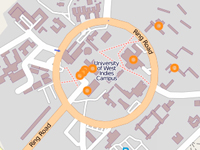Software Acquisition and Management
Software Acquisition and Management
This describes the Department’s responsibility in the area of acquisition and maintenance of software for the Mona Campus, and to outline our approach to doing it. This information is for department personnel with responsibility for software use and deployment within their departments. The management of software licensing is important in three main respects:
- Budget management
- Oversight of the contract agreement between UWI Mona and the vendor
- Resource availability for operational support and for the University’s core business – teaching, learning, research
Software Acquisition
Software licenses for the general business of the Mona Campus – management and administration, teaching, learning - must be purchased through MITS and the deployment managed by MITS. Software for projects and research, and for one-off departmental requirements may be acquired and managed by the respective Departments but installation must be done by or through MITS personnel because we hold the responsibility for the entire ICT infrastructure of the Campus.
Software used generally by the Campus, software for administration and management of the Campus’ business affairs, software integrated into the teaching curriculum will be funded centrally through the MITS budget, as far as possible and practicable.
Criteria for Selecting Software for Central Funding: see below.
Management and Administration
For the software receiving central (MITS) funding, users need only buy the media and documentation. (A list of these items is available from MITS and on the MITS website).
Note that software, whether centrally funded or not, is not available to everyone with a wish to have it. A needs basis must be established (see below for guidelines).
Licenses:
MITS determines whether to purchase a complete site license or volume licenses. This decision is largely cost driven. We weigh the cost of the site license against the volume license. It is therefore important that the departments respond appropriately to the questions we ask about usage needs. In determining the number of licenses required, we take the lesser of:
- number of users of the software
- number of machines on which it will be installed
For instance should there be the cases where 100 students are taking a course for which the software is a requirement but the lab to be used has only 40 PCs, then the number of licenses required is 40.
Distribution:
This is controlled by the MITS Software Administrator. All matters dealing with arrival, distribution, information on availability, follow up to ensure that delays are minimised are included in this responsibility.
Copies of the software are distributed to academic departments by way of the Faculty IT administrators or the lab managers ; and to the administrative departments by way of the (MITS) LAN administrators. As far as possible software is installed on the appropriate server and distributed via the network.
A list is compiled of the persons receiving the software, the target destination and the number of licenses allowed. Persons are required to sign a document confirming the receipt and acknowledging responsibility.
Maintenance and product upgrades:
Some (indeed most) of the software we purchase, offer an optional maintenance agreement at an additional cost. This usually grants us version updates and support privileges. It may also allow us to purchase the new or substantially upgraded product at an advantageous rate. Where we purchase maintenance agreements, where we purchase non-perpetual licenses, where products change substantially, where products offer new add-ons useful to our users, we manage the maintenance arrangements against two conflicting constraints a) do the benefits translate into anything of significant gain to us , and b) optimisation of our budget. We involve the users in the decision by supplying information relevant to the product and product changes and dialoguing with them about their needs.
Downloads:
Where departments require student version or free versions of teaching software to be downloaded via the internet for wide scale use the request for download may be made to MITS by the respective lecturers through the MITS Faculty IT Administrators. We wish to manage this activity in order not to overload the system with unnecessarily excessive internet traffic.
Software at a cost:
In some cases we offer software at a cost to the user departments. For UGC departments this applies to :
- Items of software which we are not able to fund centrally for budget reasons or because they do not qualify for central funding (See Software Licensing policy)
- Departments requiring items from the software list which were not intended for their use. For instance a number of Macromedia software, purchased for teaching and for specialised presentation production have been requested by persons in administration for desk top publishing. Departments are required to pay because general purpose desktop tools are already provided.
- Vendor supplied documentation (extra copies). This only applies to a few items.
For non-UGC funded departments and facilities cost is applied in the following way:
- Centrally funded software is charged back to these groups on the basis of cost recovery. Thus, where software is purchased on a per-license basis the exact cost is passed to the department. Where we purchase Campus-wide license we determine a usage cost to be passed to the departments. This will vary with the type of licensing agreement but the charge is a small fraction of the real market price of the software.
- Other items of software are charged to non-UGC departments at the exact prices at which we obtain them given our volume pricing benefits and our academic pricing benefits.
Where MITS incurs extra cost for media preparation this is passed to the departments.
Non-UGC departments may be charged a fee for handling and administration up to 10 percent of the cost of the item.
It is important to note once again that the fact that MITS might have licensed the usage of a particular item of software, does not mean that all departments or just anyone wishing to have it, is allowed it free of cost. There are specific conditions under which software is funded for departmental usage.
Guidelines for Requesting Software
The published software acquisition list will state “campus /university wide license” where this is the case. This designation means that the product is available to any department for installation on their computers. In some cases the product may even be legitimately installed on a lecturer’s personal computer as long as the computer is used to a large extent in the interest of the university. Where users are unsure of this they must contact the MITS Software Administrator for confirmation.
Where licenses are acquired in counted quantities they are available on the basis of the requests which determined the count.
Software requests addressed to MITS must be verified by the head of the requesting departments. Request for software not qualifying for central (MITS) funding must be approved by the appropriate budget holder as there is likely to be cost implications. A software request form should be completed for all software but this is mandatory for all software not classified as “Desktop software for general office automation” such as the Microsoft Office tools.
See “Request For Software” form on the MITS Website.
Where new software (ie not included in the software items list) is needed or where the user is requesting that we purchase on their behalf, a Procurement Approval form must be completed to substantiate the transaction. See “Procurement Approval” form on MITS Web site.
Criteria for Selecting Software for Central Funding through the MITS budget
Software for core Campus services and administration such as desktop software, software for administration and management of the Campus’ business affairs, software integrated in the teaching / learning curriculum, will be considered for funding centrally through the MITS budget. In order to determine the items which are eligible, the following criteria are used as a guideline:
- There is widespread demand for the software to support business operation
- It is not highly specialised and is integrated into a number areas of productivity enhancement and teaching. These include tools for project management, document enhancement ...and so on. Our budget has not allowed us to be expansive in this area.
- It is a part of the basic repertoire for teaching , learning , research and / or administration eg our GIS software, statistical analysis (SPSS base)
- It advances the Campus’ ICT Strategy
Preconditions for the above selection include:
- Adequate support is available
- MITS is able to provision training and documentation
Personnel Involved
Installation - Faculty IT Administrators (FITA):
Science and Technology- Andrea Rhule
Medical Sciences- Damien Brown
Humanities and Education- Peter Watson
Social Sciences- Nicole McKenzie
Installation: LAN Administrators
Internal (MITS) Administrators:
Software Administrator Jeremy-Dane Ferguson
Service and support requests: User Support Services


 Facebook
Facebook YouTube
YouTube Twitter
Twitter WhatsApp +1(876) 499-2291
WhatsApp +1(876) 499-2291